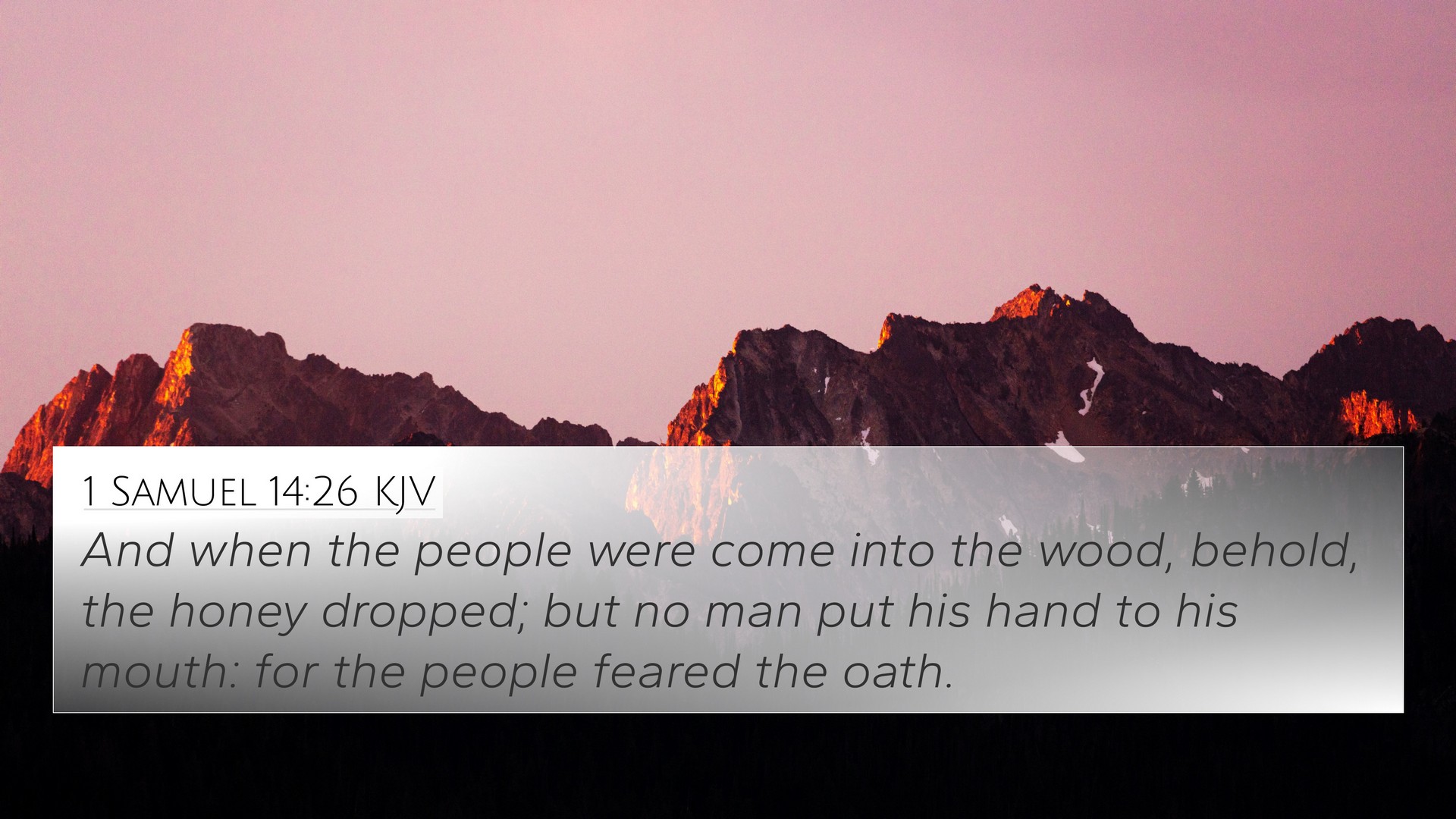Understanding 1 Samuel 14:26
Verse: 1 Samuel 14:26
In this verse, we see Saul and his men encountering honey in the forest. The verse highlights a moment of both physical and spiritual significance, reflecting on obedience to God’s commands and the challenges of leadership.
Summary of Insights from Public Domain Commentaries
Matthew Henry's Commentary
Matthew Henry emphasizes the importance of obedience in the context of Saul's leadership. The honey represents a necessary sustenance for the men after they had been under a curse imposed by Saul. Henry notes that the act of tasting the honey reflects a moment of grace amidst the burdensome obligation placed upon them. This moment can illustrate how God's provision often comes even in challenging circumstances.
Albert Barnes' Commentary
Albert Barnes presents the perspective that this moment illustrates the consequences of rash decisions and the need for discernment in leadership. He warns about the potential pitfalls of making oaths that can jeopardize the welfare of those under one’s command. The encounter with the honey serves as a turning point for the men, who, under the weight of a hasty decree, find strength in what was previously forbidden.
Adam Clarke's Commentary
Adam Clarke elaborates on the spiritual symbolism present in the verse. Honey often represents sweetness and life in biblical texts. Clarke's insight suggests that the honey is a metaphor for divine blessings, which can be found even amidst stringent rulings. Furthermore, he asserts that Saul’s misunderstanding of the law leads to a critical lesson on how spiritual leadership requires a balance of authority and compassion.
Key Themes and Important Connections
This verse underlines themes of leadership, obedience, and divine provision. Understanding 1 Samuel 14:26 requires examining similar scriptural narratives, fostering a richer interpretation through cross-referencing.
- Judges 15:14-15: The story of Samson finding honey in the carcass symbolizes the idea of finding nourishment in unexpected places.
- Proverbs 24:13-14: These verses discuss the sweetness of wisdom, paralleling the honey theme in 1 Samuel.
- Exodus 16:31: Manna is compared to honey in its sweetness, connecting divine provision to nourishment.
- Psalm 119:103: "How sweet are Your words to my taste," linking the concept of sweetness to God's Word.
- Isaiah 7:15: "Butter and honey shall he eat," indicates the spiritual sustenance God provides.
- Matthew 5:6: "Blessed are those who hunger and thirst for righteousness," relates to the longing for spiritual nourishment.
- John 6:35: Jesus as the "bread of life" symbolizes spiritual sustenance, complementing the honey's representation of nourishment.
- Galatians 5:22-23: The fruits of the Spirit, which include goodness and kindness, again reflect the sweet outcome of following God's guidance.
- James 3:17: The wisdom from God is described as "pure, then peaceable, gentle, willing to yield," which reflects the qualities of good leadership.
- Colossians 3:2: "Set your minds on things that are above," encourages believers to focus on divine provision rather than earthly constraints.
Connections Between Bible Verses
This scriptural instance calls for an analysis of similar themes throughout the Bible, particularly regarding divine sustenance, obedience, and leadership qualities. By employing a systematic approach to cross-referencing, one can derive deeper meanings and applications in one's life.
Tools for Bible Cross-Referencing
Utilizing tools like a Bible concordance can help in identifying verses that harmonize well with the central themes of 1 Samuel 14:26. This method fosters an understanding of the overarching narrative and inter-Biblical dialogue.
How to Use Bible Cross-References
Engaging in cross-reference Bible study requires diligence and openness to the connections that scripture offers. By identifying how one verse relates to another, a deeper narrative can be revealed that could support and illuminate teachings within one's faith journey.
Identifying Connections Between Old and New Testament
The practice of identifying connections between the Old and New Testament is invaluable in discovering the continuities of God’s message throughout scripture. 1 Samuel 14:26 offers a vital link that is reflected in the teachings and actions of Christ.
Conclusion
In summary, 1 Samuel 14:26 serves as a multifaceted verse rich in implications for spiritual leadership and the nature of divine provision. By examining cross-references, one can uncover broader themes of obedience, sustenance, and guidance that resonate throughout the Bible. The exercise of linking Bible scriptures not only enriches individual understanding but also enhances community discourse around biblical teachings.



